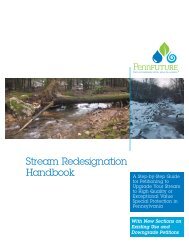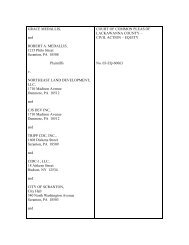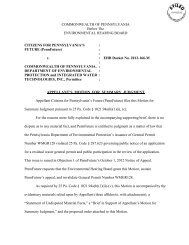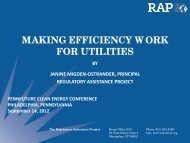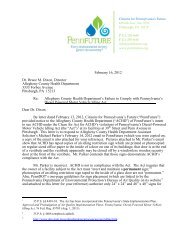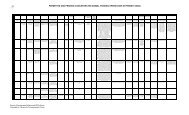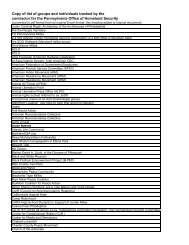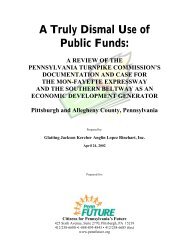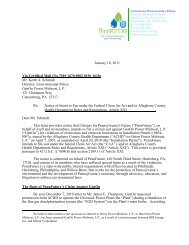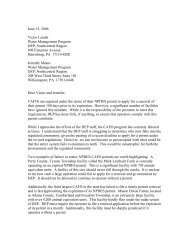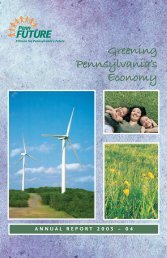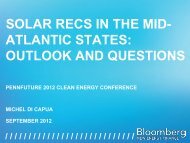A Review of the Pennsylvania Phosphorus Index ... - PennFuture
A Review of the Pennsylvania Phosphorus Index ... - PennFuture
A Review of the Pennsylvania Phosphorus Index ... - PennFuture
Create successful ePaper yourself
Turn your PDF publications into a flip-book with our unique Google optimized e-Paper software.
4. Require BMPs to reduce P loss from fields with Very High P-<strong>Index</strong> rankings.5. Attend meetings <strong>of</strong> <strong>the</strong> group which evaluates and makes recommendations formodifications to <strong>the</strong> PA P-<strong>Index</strong>. This would allow a deeper insight into <strong>the</strong> workings <strong>of</strong><strong>the</strong> P-<strong>Index</strong> and potentially, some input into how <strong>the</strong> PA P-<strong>Index</strong> is designed andimplemented.6. Evaluate <strong>the</strong> impact <strong>of</strong> extending <strong>the</strong> riparian buffer zone in Part A Screen <strong>of</strong> <strong>the</strong> P-<strong>Index</strong>to 200 feet. The data seem to indicate that <strong>the</strong> active areas <strong>of</strong> P run<strong>of</strong>f extend out thatfar.7. Conduct monitoring <strong>of</strong> targeted watersheds to determine <strong>the</strong> actual loss and riverinetransport <strong>of</strong> P from farm fields.8. The long term solution to <strong>the</strong> P imbalance in watersheds with a high density <strong>of</strong> livestockoperations is to restore <strong>the</strong> P balance. The import <strong>of</strong> feed grains to areas <strong>of</strong> dense animalproduction exceeds P removal. One possible solution may be found in an effectivemanure transport program perhaps including some processing to develop value-addedmanure-based products. Ano<strong>the</strong>r possible solution may be to decrease animal densityand substantially increased <strong>the</strong> integration <strong>of</strong> animal and crop production.ReferencesBeegle, D.B. 1999. Soil fertility management. In N. Serotkin and S. Tibbetts (eds.) TheAgronomy Guide. 1999 – 2000. Publ. Distribution Center, <strong>Pennsylvania</strong> State Univ., UniversityPark. (Reference taken from Sharpley et al 2001 as a copy could not be found in electronicsearch.)Beegle, D.B., J.L. Weld. W.J. Gbuerk, P.J. Kleinman, A.N Sharpley, and C. Kogelman. 2006.The <strong>Pennsylvania</strong> <strong>Phosphorus</strong> <strong>Index</strong>: Version 1; User Documentation (Draft).http://panutrientmgmt.cas.psu.edu/pdf/rp_P<strong>Index</strong>_Guidance_Manual0605.pdfBeegle, D.B., J.L. Weld. W.J. Gbuerk, P.J. Kleinman, A.N Sharpley, and C. Kogelman. 2009.<strong>Pennsylvania</strong>’s Nutrient Management Act Program Technical Manual (Version 4.0) - Appendix5:The <strong>Pennsylvania</strong> <strong>Phosphorus</strong> <strong>Index</strong>: Version 2 Users Guide(http://panutrientmgmt.cas.psu.edu/pdf/Technical_Manual/Appendix%205%20-%20P%20<strong>Index</strong>%202009-10.pdf).Elliott, H.A., R.C. Brandt, P.J.A. Kleinman, A.N. Sharpley, and D.G. Beegle. 2006. Estimatingsource coefficients for phosphorus site indices. J. Environ. Qual. 35:2195-2201.Gburek, W.J., A.N. Sharpely, L. Heathwaite, and G.J. Folmar. 2000. <strong>Phosphorus</strong> Managementat <strong>the</strong> watershed scale: A modification <strong>of</strong> <strong>the</strong> phosphorus index. J. Environ. Qula. 29:130-144.Page 14



